Critical Analysis of Long-Term Finance Sources: LSC UoS BA Business
VerifiedAdded on 2023/06/08
|6
|1298
|422
Report
AI Summary
This report critically analyzes the external long-term finance sources available to businesses, including sole traders, partnerships, and companies. It explores equity shares, where companies sell ownership rights for capital, debentures, which offer financing without ownership dilution, term loans from financial institutions providing flexible repayment schedules, and hire purchase, a method for financing asset acquisition over time. Each source's advantages and disadvantages are discussed, emphasizing their impact on ownership, tax implications, and financial flexibility. The report concludes that understanding these financing options is crucial for businesses seeking sustainable growth and expansion, especially when considering factors like collateral requirements and demanding approval processes. Desklib offers a range of study tools and resources for students.
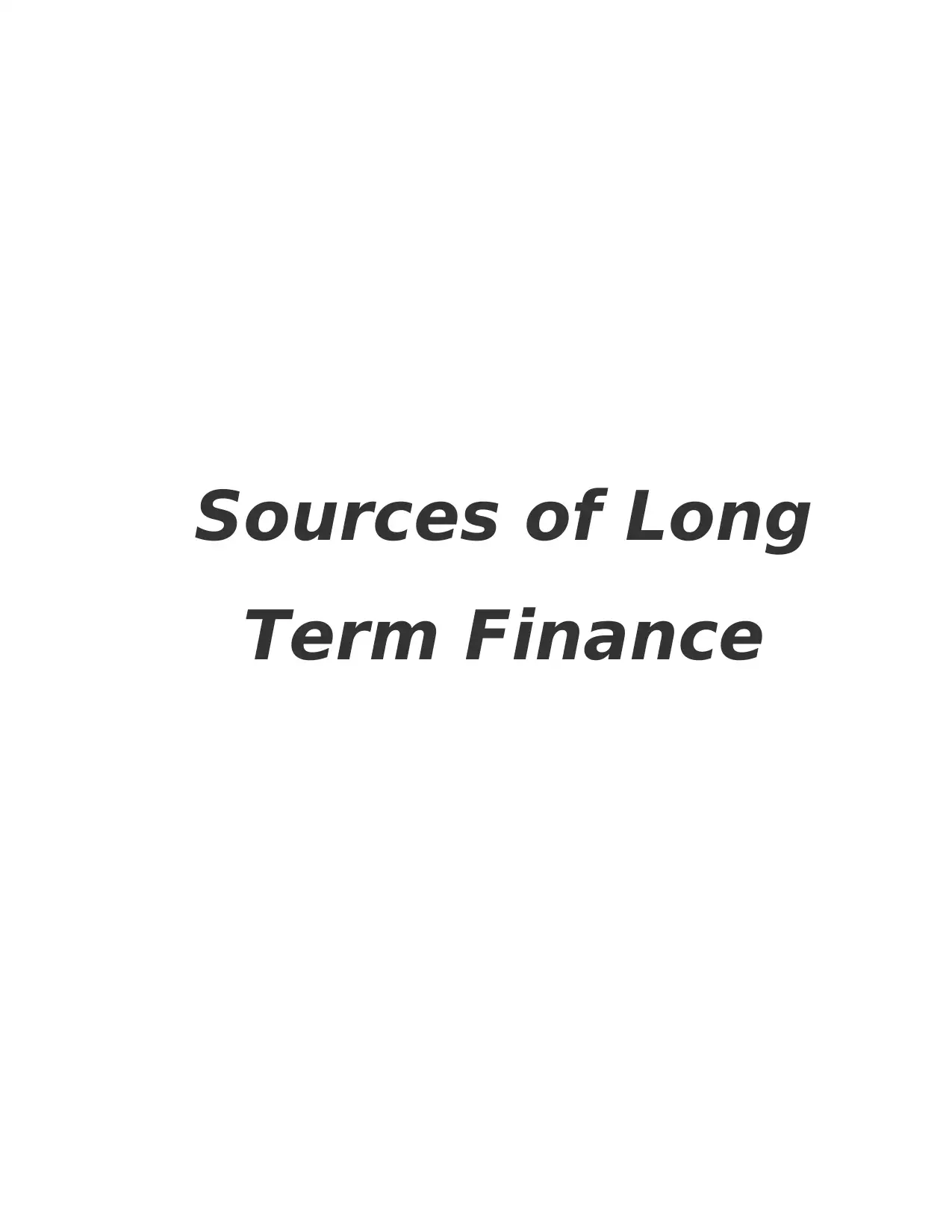
Sources of Long
Term Finance
Term Finance
Paraphrase This Document
Need a fresh take? Get an instant paraphrase of this document with our AI Paraphraser

CONTENTS
CONTENTS....................................................................................................................................2
INTRODUCTION...........................................................................................................................1
MAIN BODY..................................................................................................................................1
CONCLUSION................................................................................................................................2
REFERENCES................................................................................................................................4
CONTENTS....................................................................................................................................2
INTRODUCTION...........................................................................................................................1
MAIN BODY..................................................................................................................................1
CONCLUSION................................................................................................................................2
REFERENCES................................................................................................................................4
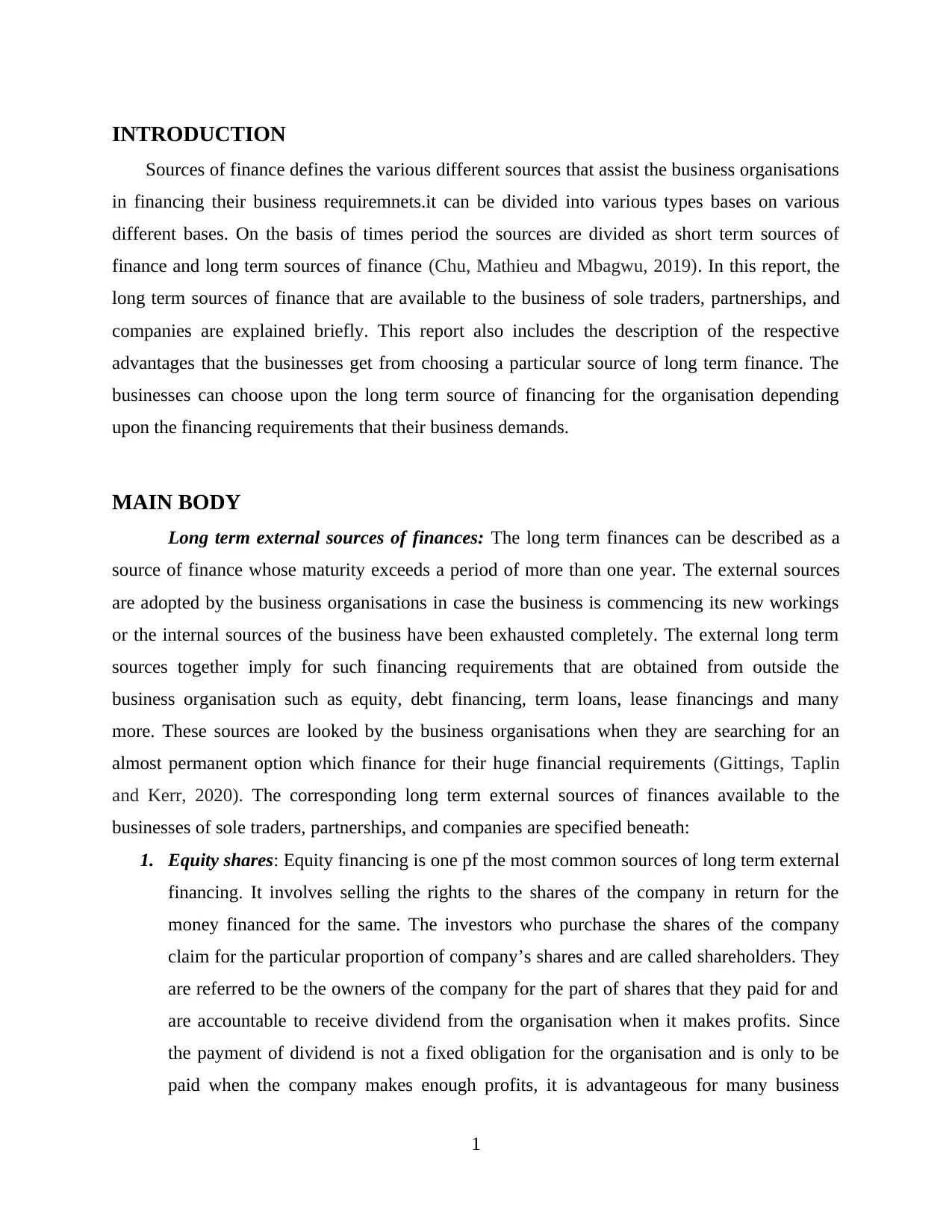
INTRODUCTION
Sources of finance defines the various different sources that assist the business organisations
in financing their business requiremnets.it can be divided into various types bases on various
different bases. On the basis of times period the sources are divided as short term sources of
finance and long term sources of finance (Chu, Mathieu and Mbagwu, 2019). In this report, the
long term sources of finance that are available to the business of sole traders, partnerships, and
companies are explained briefly. This report also includes the description of the respective
advantages that the businesses get from choosing a particular source of long term finance. The
businesses can choose upon the long term source of financing for the organisation depending
upon the financing requirements that their business demands.
MAIN BODY
Long term external sources of finances: The long term finances can be described as a
source of finance whose maturity exceeds a period of more than one year. The external sources
are adopted by the business organisations in case the business is commencing its new workings
or the internal sources of the business have been exhausted completely. The external long term
sources together imply for such financing requirements that are obtained from outside the
business organisation such as equity, debt financing, term loans, lease financings and many
more. These sources are looked by the business organisations when they are searching for an
almost permanent option which finance for their huge financial requirements (Gittings, Taplin
and Kerr, 2020). The corresponding long term external sources of finances available to the
businesses of sole traders, partnerships, and companies are specified beneath:
1. Equity shares: Equity financing is one pf the most common sources of long term external
financing. It involves selling the rights to the shares of the company in return for the
money financed for the same. The investors who purchase the shares of the company
claim for the particular proportion of company’s shares and are called shareholders. They
are referred to be the owners of the company for the part of shares that they paid for and
are accountable to receive dividend from the organisation when it makes profits. Since
the payment of dividend is not a fixed obligation for the organisation and is only to be
paid when the company makes enough profits, it is advantageous for many business
1
Sources of finance defines the various different sources that assist the business organisations
in financing their business requiremnets.it can be divided into various types bases on various
different bases. On the basis of times period the sources are divided as short term sources of
finance and long term sources of finance (Chu, Mathieu and Mbagwu, 2019). In this report, the
long term sources of finance that are available to the business of sole traders, partnerships, and
companies are explained briefly. This report also includes the description of the respective
advantages that the businesses get from choosing a particular source of long term finance. The
businesses can choose upon the long term source of financing for the organisation depending
upon the financing requirements that their business demands.
MAIN BODY
Long term external sources of finances: The long term finances can be described as a
source of finance whose maturity exceeds a period of more than one year. The external sources
are adopted by the business organisations in case the business is commencing its new workings
or the internal sources of the business have been exhausted completely. The external long term
sources together imply for such financing requirements that are obtained from outside the
business organisation such as equity, debt financing, term loans, lease financings and many
more. These sources are looked by the business organisations when they are searching for an
almost permanent option which finance for their huge financial requirements (Gittings, Taplin
and Kerr, 2020). The corresponding long term external sources of finances available to the
businesses of sole traders, partnerships, and companies are specified beneath:
1. Equity shares: Equity financing is one pf the most common sources of long term external
financing. It involves selling the rights to the shares of the company in return for the
money financed for the same. The investors who purchase the shares of the company
claim for the particular proportion of company’s shares and are called shareholders. They
are referred to be the owners of the company for the part of shares that they paid for and
are accountable to receive dividend from the organisation when it makes profits. Since
the payment of dividend is not a fixed obligation for the organisation and is only to be
paid when the company makes enough profits, it is advantageous for many business
1
⊘ This is a preview!⊘
Do you want full access?
Subscribe today to unlock all pages.

Trusted by 1+ million students worldwide
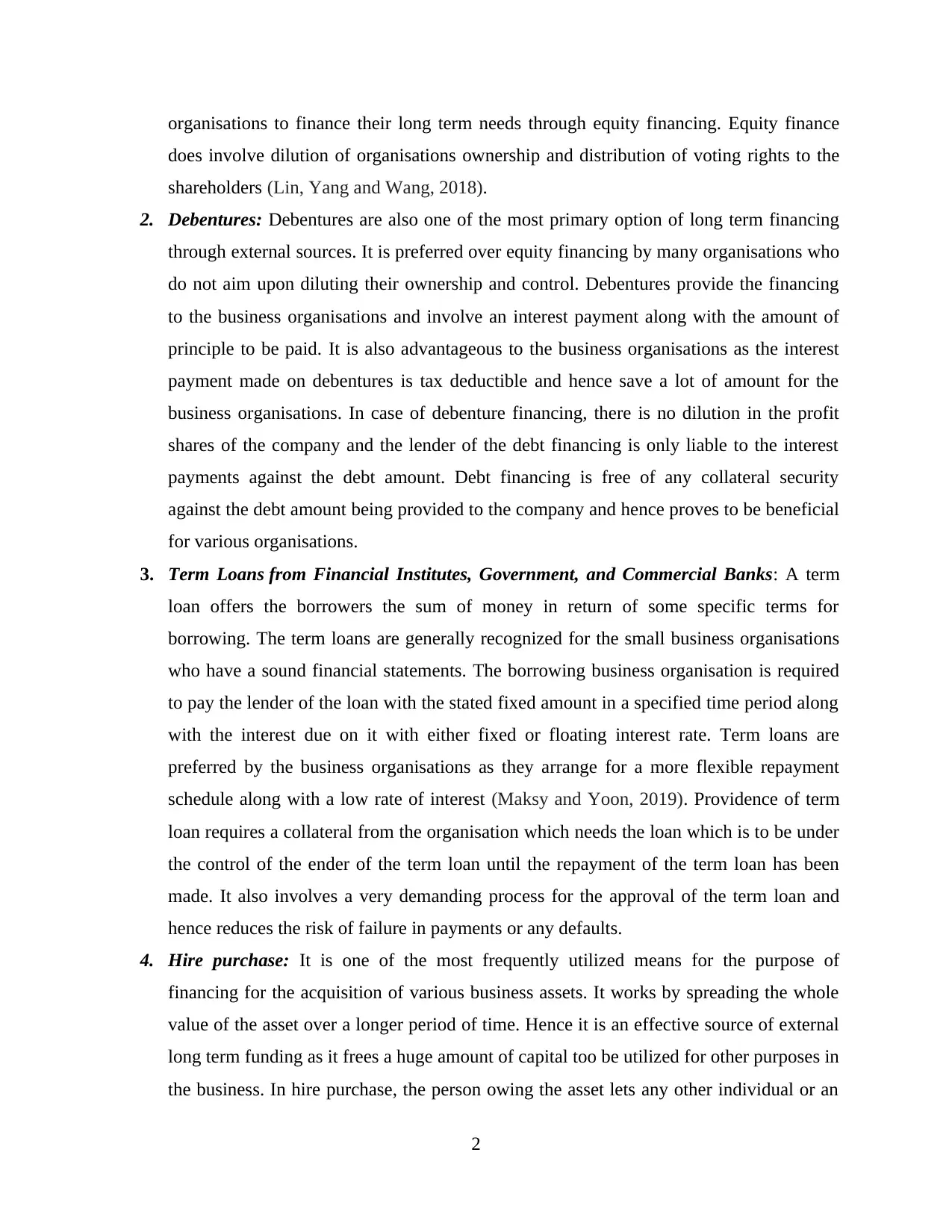
organisations to finance their long term needs through equity financing. Equity finance
does involve dilution of organisations ownership and distribution of voting rights to the
shareholders (Lin, Yang and Wang, 2018).
2. Debentures: Debentures are also one of the most primary option of long term financing
through external sources. It is preferred over equity financing by many organisations who
do not aim upon diluting their ownership and control. Debentures provide the financing
to the business organisations and involve an interest payment along with the amount of
principle to be paid. It is also advantageous to the business organisations as the interest
payment made on debentures is tax deductible and hence save a lot of amount for the
business organisations. In case of debenture financing, there is no dilution in the profit
shares of the company and the lender of the debt financing is only liable to the interest
payments against the debt amount. Debt financing is free of any collateral security
against the debt amount being provided to the company and hence proves to be beneficial
for various organisations.
3. Term Loans from Financial Institutes, Government, and Commercial Banks: A term
loan offers the borrowers the sum of money in return of some specific terms for
borrowing. The term loans are generally recognized for the small business organisations
who have a sound financial statements. The borrowing business organisation is required
to pay the lender of the loan with the stated fixed amount in a specified time period along
with the interest due on it with either fixed or floating interest rate. Term loans are
preferred by the business organisations as they arrange for a more flexible repayment
schedule along with a low rate of interest (Maksy and Yoon, 2019). Providence of term
loan requires a collateral from the organisation which needs the loan which is to be under
the control of the ender of the term loan until the repayment of the term loan has been
made. It also involves a very demanding process for the approval of the term loan and
hence reduces the risk of failure in payments or any defaults.
4. Hire purchase: It is one of the most frequently utilized means for the purpose of
financing for the acquisition of various business assets. It works by spreading the whole
value of the asset over a longer period of time. Hence it is an effective source of external
long term funding as it frees a huge amount of capital too be utilized for other purposes in
the business. In hire purchase, the person owing the asset lets any other individual or an
2
does involve dilution of organisations ownership and distribution of voting rights to the
shareholders (Lin, Yang and Wang, 2018).
2. Debentures: Debentures are also one of the most primary option of long term financing
through external sources. It is preferred over equity financing by many organisations who
do not aim upon diluting their ownership and control. Debentures provide the financing
to the business organisations and involve an interest payment along with the amount of
principle to be paid. It is also advantageous to the business organisations as the interest
payment made on debentures is tax deductible and hence save a lot of amount for the
business organisations. In case of debenture financing, there is no dilution in the profit
shares of the company and the lender of the debt financing is only liable to the interest
payments against the debt amount. Debt financing is free of any collateral security
against the debt amount being provided to the company and hence proves to be beneficial
for various organisations.
3. Term Loans from Financial Institutes, Government, and Commercial Banks: A term
loan offers the borrowers the sum of money in return of some specific terms for
borrowing. The term loans are generally recognized for the small business organisations
who have a sound financial statements. The borrowing business organisation is required
to pay the lender of the loan with the stated fixed amount in a specified time period along
with the interest due on it with either fixed or floating interest rate. Term loans are
preferred by the business organisations as they arrange for a more flexible repayment
schedule along with a low rate of interest (Maksy and Yoon, 2019). Providence of term
loan requires a collateral from the organisation which needs the loan which is to be under
the control of the ender of the term loan until the repayment of the term loan has been
made. It also involves a very demanding process for the approval of the term loan and
hence reduces the risk of failure in payments or any defaults.
4. Hire purchase: It is one of the most frequently utilized means for the purpose of
financing for the acquisition of various business assets. It works by spreading the whole
value of the asset over a longer period of time. Hence it is an effective source of external
long term funding as it frees a huge amount of capital too be utilized for other purposes in
the business. In hire purchase, the person owing the asset lets any other individual or an
2
Paraphrase This Document
Need a fresh take? Get an instant paraphrase of this document with our AI Paraphraser
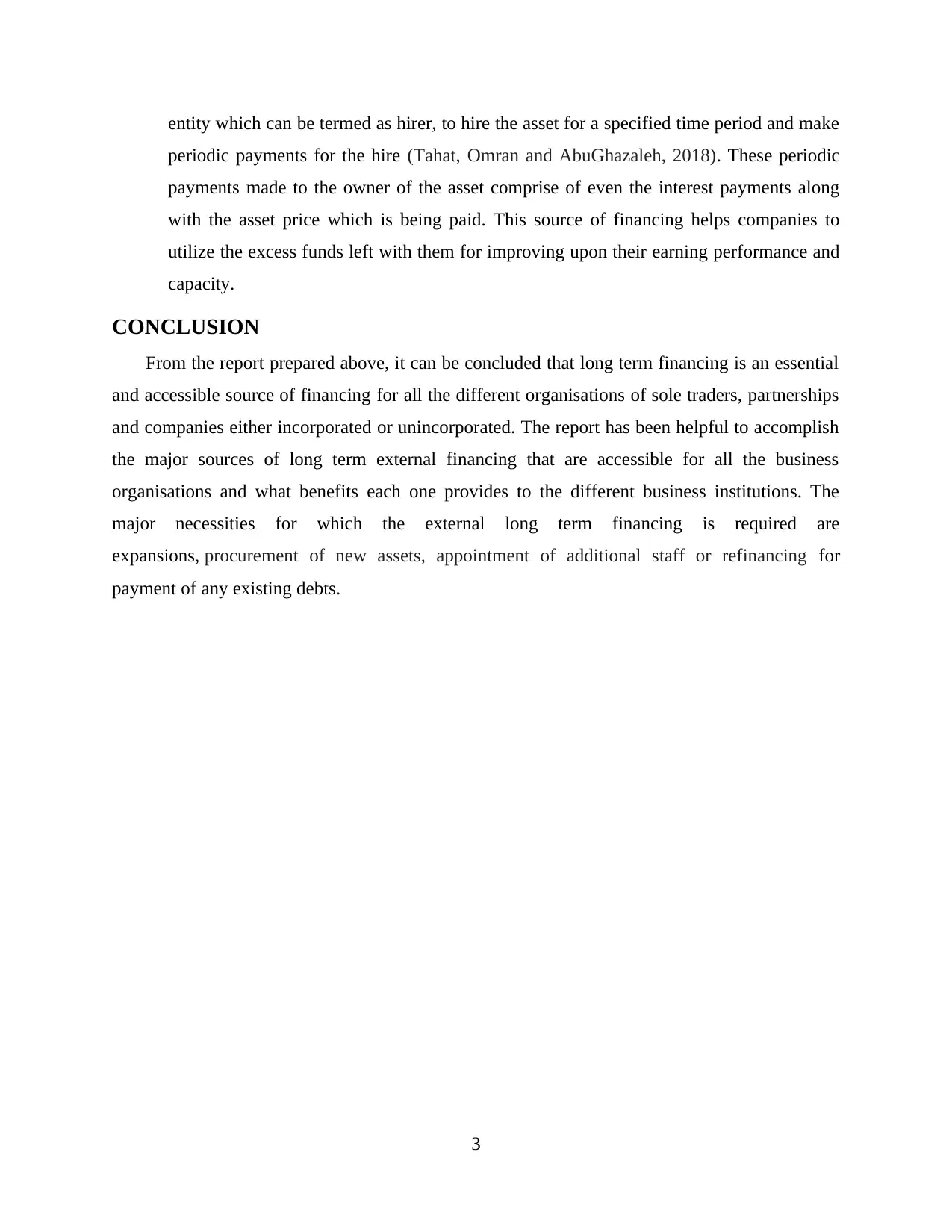
entity which can be termed as hirer, to hire the asset for a specified time period and make
periodic payments for the hire (Tahat, Omran and AbuGhazaleh, 2018). These periodic
payments made to the owner of the asset comprise of even the interest payments along
with the asset price which is being paid. This source of financing helps companies to
utilize the excess funds left with them for improving upon their earning performance and
capacity.
CONCLUSION
From the report prepared above, it can be concluded that long term financing is an essential
and accessible source of financing for all the different organisations of sole traders, partnerships
and companies either incorporated or unincorporated. The report has been helpful to accomplish
the major sources of long term external financing that are accessible for all the business
organisations and what benefits each one provides to the different business institutions. The
major necessities for which the external long term financing is required are
expansions, procurement of new assets, appointment of additional staff or refinancing for
payment of any existing debts.
3
periodic payments for the hire (Tahat, Omran and AbuGhazaleh, 2018). These periodic
payments made to the owner of the asset comprise of even the interest payments along
with the asset price which is being paid. This source of financing helps companies to
utilize the excess funds left with them for improving upon their earning performance and
capacity.
CONCLUSION
From the report prepared above, it can be concluded that long term financing is an essential
and accessible source of financing for all the different organisations of sole traders, partnerships
and companies either incorporated or unincorporated. The report has been helpful to accomplish
the major sources of long term external financing that are accessible for all the business
organisations and what benefits each one provides to the different business institutions. The
major necessities for which the external long term financing is required are
expansions, procurement of new assets, appointment of additional staff or refinancing for
payment of any existing debts.
3
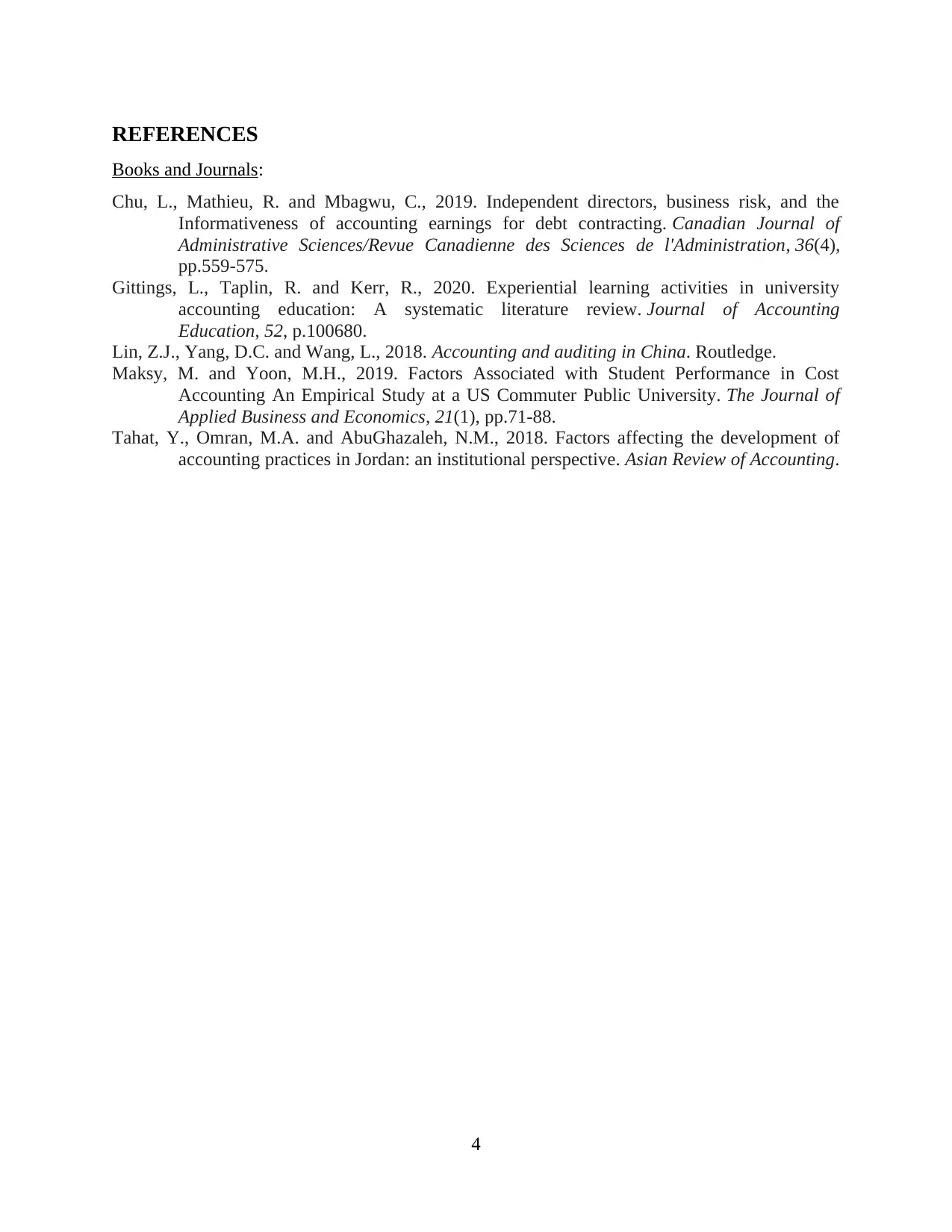
REFERENCES
Books and Journals:
Chu, L., Mathieu, R. and Mbagwu, C., 2019. Independent directors, business risk, and the
Informativeness of accounting earnings for debt contracting. Canadian Journal of
Administrative Sciences/Revue Canadienne des Sciences de l'Administration, 36(4),
pp.559-575.
Gittings, L., Taplin, R. and Kerr, R., 2020. Experiential learning activities in university
accounting education: A systematic literature review. Journal of Accounting
Education, 52, p.100680.
Lin, Z.J., Yang, D.C. and Wang, L., 2018. Accounting and auditing in China. Routledge.
Maksy, M. and Yoon, M.H., 2019. Factors Associated with Student Performance in Cost
Accounting An Empirical Study at a US Commuter Public University. The Journal of
Applied Business and Economics, 21(1), pp.71-88.
Tahat, Y., Omran, M.A. and AbuGhazaleh, N.M., 2018. Factors affecting the development of
accounting practices in Jordan: an institutional perspective. Asian Review of Accounting.
4
Books and Journals:
Chu, L., Mathieu, R. and Mbagwu, C., 2019. Independent directors, business risk, and the
Informativeness of accounting earnings for debt contracting. Canadian Journal of
Administrative Sciences/Revue Canadienne des Sciences de l'Administration, 36(4),
pp.559-575.
Gittings, L., Taplin, R. and Kerr, R., 2020. Experiential learning activities in university
accounting education: A systematic literature review. Journal of Accounting
Education, 52, p.100680.
Lin, Z.J., Yang, D.C. and Wang, L., 2018. Accounting and auditing in China. Routledge.
Maksy, M. and Yoon, M.H., 2019. Factors Associated with Student Performance in Cost
Accounting An Empirical Study at a US Commuter Public University. The Journal of
Applied Business and Economics, 21(1), pp.71-88.
Tahat, Y., Omran, M.A. and AbuGhazaleh, N.M., 2018. Factors affecting the development of
accounting practices in Jordan: an institutional perspective. Asian Review of Accounting.
4
⊘ This is a preview!⊘
Do you want full access?
Subscribe today to unlock all pages.

Trusted by 1+ million students worldwide
1 out of 6
Related Documents
Your All-in-One AI-Powered Toolkit for Academic Success.
+13062052269
info@desklib.com
Available 24*7 on WhatsApp / Email
![[object Object]](/_next/static/media/star-bottom.7253800d.svg)
Unlock your academic potential
Copyright © 2020–2025 A2Z Services. All Rights Reserved. Developed and managed by ZUCOL.



